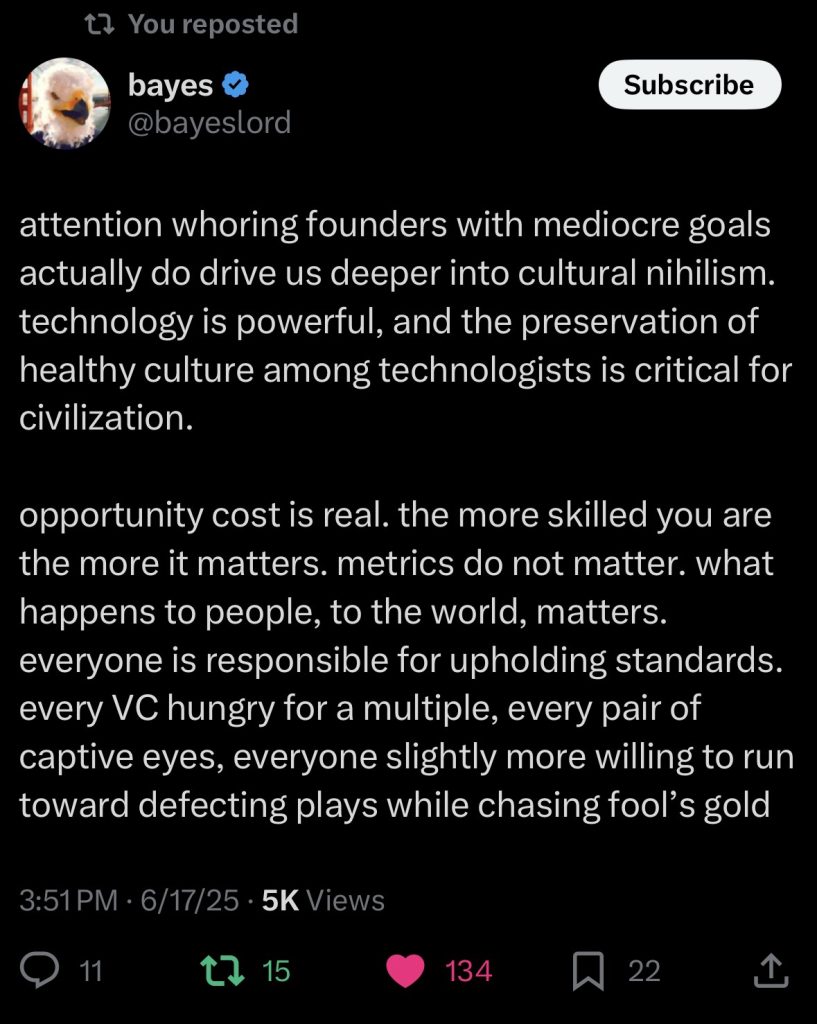While I’m not economist, because, well there wasn’t money to pay for graduate school, so I could not dedicate myself to the study of monetary policy. I had to go make money in the markets like a capitalist should.
So I’m aware that my thought experiment is not how any of this works, it’s against free market principles to arrange markets like this, but let’s do a thought experiment about buying back our industrial capacity.
Being inspired by Roon’s tweet about Silicon Valley’s grand tradition of acqui-hiring and taking seriously the thesis of Dan Wang’s book Breakneck.
That “industrial process” is a technology that lives in the heads of people and that it was a mistake to let so much “low value” industry be offshored due to the loss of tacit process capital
So what kind of companies would America want to acquire if we were so inclined to pursue a strategy of industrialization? Our biggest success is that we are a highly financialized economy.
So why not use that cash to buy some shit? I know I don’t like planned markets either but for our industrialists let’s say we find a way for America’s markets to buy us back some process knowledge.
Let’s take a stab at what we’d even want in that day. For me my starting point is the top ten Korean chaebols, we take back AMD from Europe (we licensed it anyways) and look to acqui-hire former Nokia Finnish & Baltic system engineers.
Now maybe you want 1 or 2 Indian pharmaceutical generics providers to come to American. And for fun let’s buy the Japanese fastener company YKK. And also buy back the meatpackers. I asked Grok what it would cost and I was honestly pretty pleased by the price tag.
Based on current data (Sep 2025):
- Top 10 Korean chaebols (flagship mkt caps): ~$879B
- AMD: $261B
- Nokia: $26B
- Top 2 Indian generics (Sun Pharma, Cipla): $61B
- YKK: Private (N/A)
- Major meatpackers (JBS, WH Group): $30B
Total: ~$1.26 trillion. Note: Estimates for groups; exact values fluctuates
We would probably need to buy the shareholders and the workers so let’s assume it’s kind of a buyout but you are getting the talent too.
We get the best possible new Americans and we make their shareholders money. Capitalism buys American bonds. Usually. So then I think how much of our GDP would that be?
Current US GDP (2024): ~$29.2 trillion. 2025 projection: ~$29.7T. The $1.26T total is about 4% of annual GDP. Affordability for acquisitions would depend on financing, government subsidies, or private capital, but the economy’s scale makes it feasible in theory
Now I start to get greedy. I want the top 10 best Shenzhen manufacturers and asked for Grok’s best estimate on cost. No facts checked here it’s vibe economics ok?
Based on Sep 2025 data and estimates (public caps in USD; privates approximated via valuations):
- Huawei (telecom/electronics): ~$300B (private)
- BYD (EVs/batteries): $133B
- Luxshare Precision (components): $70B
- Mindray (medical devices): $41B
- ZTE (telecom equip): $25B
- TCL Technology (electronics): $20B
- Inovance (automation): $20B
- Goertek (acoustics/wearables): $15B
- Sunny Optical (optics): $12B
- Han’s Laser (laser equip): $6B
Total est. acquisition cost: ~$642B. Feasible under your presumptions, ~2% of US GDP
So just vibe economics here but like how much did we spend on pandemic stimulus?
Total US COVID-19 fiscal stimulus (2020-2021 packages) was about $5.6 trillion, per Tax Policy Center estimates, including spending and tax relief. That’s roughly 19% of current GDP—way more than your 6% shopping list. Feasible in scale, if the will is there!
So again just vibes not how it works but stay with me here to keep the American consumer spending (which I am not saying didn’t work because it did) but we spent 19% of our GDP in stimulus. And we didn’t get better companies or better Americans.









